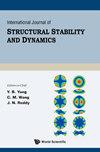Component Mode Synthesis Based on the Energy Method for Frequency Domain Dynamic Response Analysis of Ballastless Track Structure
IF 3.4
3区 工程技术
Q2 ENGINEERING, CIVIL
International Journal of Structural Stability and Dynamics
Pub Date : 2023-10-12
DOI:10.1142/s0219455424501438
引用次数: 0
Abstract
Used extensively in structural dynamics analysis, the energy method is advantageous for transforming boundary value problems of differential equations into variational extremum problems. Recent applications include analyzing the wave and vibration characteristics of track structures. However, traditional energy methods for dynamic modeling and analysis of ballastless track structures require obtaining the global stiffness matrix and mass matrix of the entire coupled system, which decreases computational efficiency. The EM-CMS algorithm for frequency domain dynamic response analysis of ballastless track structures has been proposed to address this issue. The core of EM-CMS is the development of model reduction strategies within the framework of the energy method to reduce matrix dimensions and thereby improve computational efficiency. Specifically, the steel spring floating slab track is the focus of this research. Utilizing the energy functional variational method, the modal properties of the rail and floating slab structures are obtained, and truncation is performed. A reduced-order model for the steel spring floating slab track is established by considering the boundary conditions between the rail-floating slab and the floating slab foundation (connected through fastener springs and steel springs, respectively, and considering the springs’ elastic potential energy). Comparatively, the computational efficiency of EM-CMS is approximately ten times greater than that of the energy method. The method’s accuracy is also carefully validated against finite element simulations.基于能量法的无砟轨道结构频域动力响应分析模态综合
能量法在结构动力学分析中广泛应用,它有利于将微分方程的边值问题转化为变分极值问题。最近的应用包括分析轨道结构的波动和振动特性。然而,传统的无砟轨道结构动力学建模和分析的能量方法需要获得整个耦合系统的整体刚度矩阵和质量矩阵,从而降低了计算效率。针对这一问题,提出了无砟轨道结构频域动力响应分析的EM-CMS算法。EM-CMS的核心是在能量法框架内开发模型降维策略,以降低矩阵维数,从而提高计算效率。其中,钢弹簧浮板轨道是本文研究的重点。利用能量泛函变分法,得到了钢轨和浮板结构的模态特性,并进行了截断。考虑轨道浮板与浮板基础(分别通过扣件弹簧和钢弹簧连接,并考虑弹簧的弹性势能)之间的边界条件,建立了钢弹簧浮板轨道的降阶模型。相比之下,EM-CMS的计算效率大约是能量法的十倍。该方法的准确性也经过了有限元模拟的仔细验证。
本文章由计算机程序翻译,如有差异,请以英文原文为准。
求助全文
约1分钟内获得全文
求助全文
来源期刊
CiteScore
5.30
自引率
38.90%
发文量
291
审稿时长
4 months
期刊介绍:
The aim of this journal is to provide a unique forum for the publication and rapid dissemination of original research on stability and dynamics of structures. Papers that deal with conventional land-based structures, aerospace structures, marine structures, as well as biostructures and micro- and nano-structures are considered. Papers devoted to all aspects of structural stability and dynamics (both transient and vibration response), ranging from mathematical formulations, novel methods of solutions, to experimental investigations and practical applications in civil, mechanical, aerospace, marine, bio- and nano-engineering will be published.
The important subjects of structural stability and structural dynamics are placed together in this journal because they share somewhat fundamental elements. In recognition of the considerable research interests and recent proliferation of papers in these subjects, it is hoped that the journal may help bring together papers focused on related subjects, including the state-of-the-art surveys, so as to provide a more effective medium for disseminating the latest developments to researchers and engineers.
This journal features a section for technical notes that allows researchers to publish their initial findings or new ideas more speedily. Discussions of papers and concepts will also be published so that researchers can have a vibrant and timely communication with others.

 求助内容:
求助内容: 应助结果提醒方式:
应助结果提醒方式:


